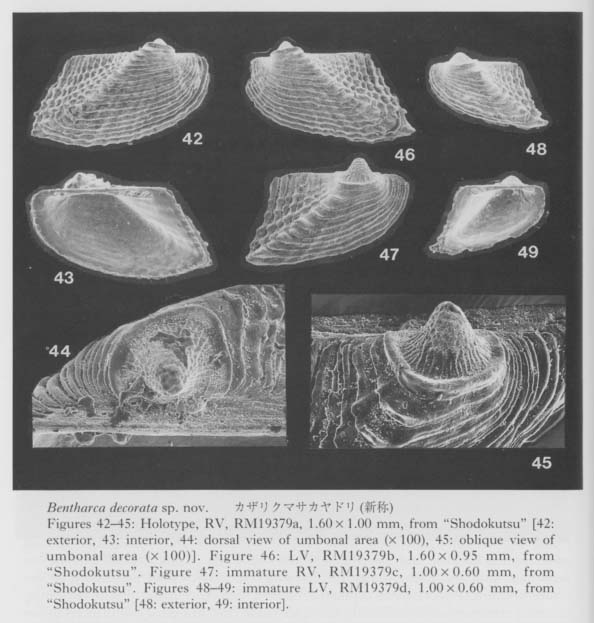Bentharca decorata sp. nov.
Figures 42-49

1992. Bentharca sp. C, Kase and Hayami,Jour. Moll. Studies, vol.58, p.447, figs.1A, B, p.448, listed.
1993. Bentharca sp., Hayami and Kase, Univ. Mus. Univ. Tokyo, News, no.27, p.3, fig.2.
Type and material.—Holotype: RM19379a, a right valve from the bottom sediments of "Shodokutsu" of Ie Islet, Okinawa. Paratypes: RM19376 (dead) from "Witch's House", RM19377 (dead) from "Black Hole", RM19579 (dead) from "Coral Hole" of Shimoji Islet. RM19378 (dead) from "Lunch Hole" of Irabu Islet. RM19379 (dead) from the type locality. Living specimens have not been found.
Diagnosis.—Very small, thick, subtrapezoidal and sharply carinated species of Bentharca, characterized by very strong and regularly spaced commarginal lamellae, obscure radial ribs on flank, depressed posterior area, indistinct marginal crenulation and very large hat-shaped Pd I.
Description.—Shell never exceeds 1.8 mm in length, white and opaque, thick, subtrapezoidal, about 1.6 times longer than high, sharply carinated. Posterior margin a little concave, obliquely truncates dorsal margin and forms an acute angle with venter. Ventral margin broadly convex; byssal indentation indistinct. Umbo slightly prosogyrous, incurved, located about one-fourth of dorsal margin from anterior end. Flank not sulcated, covered with very conspicuous and subequally spaced commarginal lamellae and about 15 obscure radial ribs. Commarginal lamellae on flank more prominent than radial ribs, forming conspicuous scaly projections on the posterior carina. Posterior area depressed, marked with cancellate sculpture consisting of strong commarginal lamellae and about six radial ribs. Marginal crenulations indistinct except for several along posterior margin. Ligament area moderately wide. Dentition consists of two or three granular anterior teeth and three or four short opisthoclinal posterior teeth. Pd I extremely large, hat-shaped with a highly salient central boss and a broad and flattened brim, radially or diagonally sculptured, ranging 279-301 µm in maximum diameter; Pd II absent.
Remarks.—The present species is represented by numerous disarticulated valves from the bottom sediments of "Shodokutsu". It is easily distinguishable from other cave arcids by the presence of widely spaced strong commarginal lamellae and huge hat-shaped Pd I (Figures 44, 45). The prodissoconch feature suggests nonplanktotrophic development and probably parental incubation of juveniles, but we have not yet succeeded in collecting living specimens.
Such an abnormal shape of Pd I was described and illustrated by Barnard (1964, p.372) in a specimen of "Arca (Acar) plicata" from the lower neritic bottom of Natal. Arca (Acar) aghulhasensis Thiele in Thiele and Jaeckel (1931) from Torres Strait, which was regarded by Barnard (1964) as synonymous with A. (A.) plicata, may also have abnormal Pd I, judging from the original line-drawing figure. Arca (Acar) plicata (Dillwyn, 1817) has been regarded as widely distributed in the Indo-West Pacific, but, so far as we are aware, no Japanese specimen of this species reveals such an abnormal prodissoconch. Furthermore, A. (A.) plicata differs from the present species in the much larger shell size, less reduced anterior part and more strikingly cancellate ornament on the flank.
Distribution.—Common in a sublittoral cave of Ie Islet, and rare in a few sublittoral caves of Shimoji Islet, Ryukyu Islands.